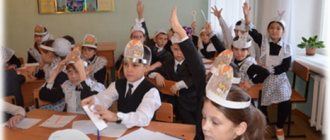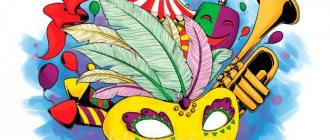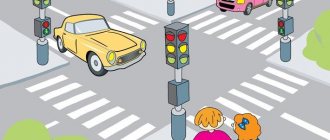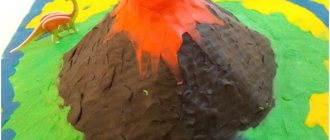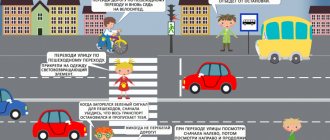MAGAZINE Preschooler.RF
Summary of the environmental quiz “Young Nature Experts”(for children of the preparatory group)
Conducted and prepared by the teacher: Potapycheva Natalya Gennadievna, State budgetary preschool educational institution kindergarten No. 29 of the Petrodvortsovo district of St. Petersburg
Target:
- Expand children's horizons with information about the life of animals, birds, and plants.
- Reinforce the rules of behavior in nature.
Program content:
Educational objectives:
- Enrich the personal experience of a child’s positive, humane interaction with nature. Expand environmentally valuable contacts of children with plants and animals, objects of inanimate nature.
- Strengthen the cognitive interest of love for nature, as well as aesthetic feelings.
Educational tasks:
- Cultivate a caring attitude towards your native land.
- Foster love and respect for nature.
- Foster a sense of friendship and mutual assistance.
- Expand children's horizons with information about the life of animals, birds, and plants.
- Reinforce the rules of behavior in nature.
Developmental tasks:
- Develop speech, attention, memory.
- Develop children's creative abilities.
Preliminary work.
- View the presentation "nature"
- Memorizing poems, proverbs, asking riddles about nature and weather;
- Conversations with children about endangered animals and plants that are listed in the Red Book;
- We held a competition of advertising posters “Do not harm nature” ;
- Board and educational games about nature and weather:
- "Edible and Inedible";
- "Field, forest, vegetable garden";
- "Fishermen and Fishes";
- Lotto "Domestic and wild animals" .
- Consideration of the encyclopedia “Animals and Plants of Our Nature”
- Watching videos about nature;
- Observation while walking.
- Learning movements and songs.
Objectives by educational areas:
NGO "Poznanie"
- Formation of an initial system of value orientations (perception of oneself as a part of nature, the relationship between man and nature).
- Formation of initial skills and habits of environmentally literate behavior that is safe for nature and for the child himself.
NGO "Communication"
- develop the ability to think logically, draw conclusions, inferences, develop communication skills;
- activate your vocabulary with new words
- teach team members to act together
NGO "Health"
- To form in children the concept that “tearing plants is not allowed” , we can thereby cause harm to the surrounding nature, and therefore to ourselves. After all, man is a part of nature.
OO "Trud"
- develop a desire to work, to make your contribution to the cleansing of our planet from human waste products (garbage collection).
NGO "Music"
- bring children joy and pleasure from joint dance compositions.
Material:
- multimedia equipment
- plant seed kits;
- globe;
- record player
- animal costumes;
- cards.
Quiz progress:
The children enter the hall to the music. They take out tokens of 2 different colors and sit down according to the color of the token.
Leading:
- Hello, dear guys! Today we have gathered to hold an environmental quiz . ” Our quiz involves two teams.
I will ask the teams to come up with names for their teams.
1 team...
2nd team...
— Please greet the teams with loud applause.
Leading:
I hugged the globe. One over land and water. In my hands the continents quietly whisper to me: “Take care .
The forest and valley are painted green. They tell me: “Be kind to us . Don’t trample us, don’t burn us, take care of us in winter and summer.”
A deep river gurgles, caressing its banks, and I hear the voice of the river: “Take care of us, take care of us .
I hear everyone from both birds and fish: “We ask you, man. Promise us and don't lie. Take care of us like an older brother.”
So that the flowers bloom in the forest, We will not collect large bouquets of them all spring and summer.
If the chick flies out of the nest before its time, We will help, no problem, Don’t crack, magpie.
Even though the fly agaric is harmful, we will not touch it. Suddenly the Forest Dweller needs him.
The fragile house of the ant must also be protected. He must definitely stand behind the fence.
Bunny and hedgehog - Forest dwellers You better not touch! Keep them safe! Let's protect nature, preschoolers!
We must not forget about her for a minute. After all, flowers, forests, fields and rivers, This is all for us forever!
— Our planet is like a big and beautiful house
“She delights us with gentle morning sunrises, colorful farewell sunsets, and landscapes of our native nature.”
— It fascinates us with its huge, deep and endless oceans, the expanses of the seas
— Surprising with high mountains, large slopes and hills
— Admires the dense, fragrant groves, pine forests, mighty oak forests
— Earth is a planet of harmony. Everything on it is proportionate and interconnected
— The nature of the planet is perfect
— Guys, do you see how beautiful the nature of our planet Earth is? Now let’s check what you know about the nature of planet Earth.
Competition “Find the correct answer” Envelope No. 1
(task explanation)
— There are pictures of seeds on the tray, look at them. Tell me, what plant does this seed come from? For the correct answer, the team receives a token. Time has passed!
(seeds: pumpkin, cucumber, sunflower seeds, watermelon, apple, cherry, persimmon)
Competition "What's extra?" Envelope No. 2
- I’ll ask you to open the envelope. Carefully look at the pictures and answer the question what is superfluous and why do you think so?
- Whoever answers the fastest and correctly will receive the coveted token.
Competition “Recognize by silhouette” Envelope No. 3
Host: Now let’s check how much you know the animal world.
Look carefully at the picture, all the animals are mixed up. You must name all the animals that are depicted here.
— Whoever answers the fastest and correctly will receive the coveted token
Musical break “The deer has a big house”
Competition "Forest Theater" No. 4
(task explanation)
Leading:
— Once a fox, a hare and a bear met in a forest clearing. And they began to tell each other about their animal lives. Listen to the story and say what is true and what is not true.
Fox:
“I live well in the forest, every bush is my home.” I only like to eat berries and plant roots.
Hare:
- My house is small and cozy. I keep it clean and tidy. I wash the windows all day, clean them and sweep away the dust.
Bear:
“And I went to the anthill, stuck my paw in and started licking it - it was very tasty.” And then he went to the river to catch fish.
Fox:
- Yes, Mishenka, I love fish myself. I breed it in my pond, feed it and grow it.
Bear:
- It’s not easy for me in the spring. I've lost weight over the winter and my appetite is good. Now I’m going to go collect acorns and the first mushrooms in the thawed patches.
Hare:
“You’re all talking to yourself, talking to yourself, and I’m taking care of my bunnies all day.” I sit and do not leave the nest, protecting my children with my breasts.
(summarizing and distributing tokens for correct answers)
Competition "Lost" Envelope No. 5
Host: Look carefully at the picture and quickly name who lost what?
Competition “Answer correctly” No. 6
Presenter: There is a poster on the board with a picture of a bird’s beak and paws. I will name the bird, and you must find the beak (paws) of the bird that I name.
Competition “Fold the picture” No. 7
— Whoever answers the fastest and correctly will receive the coveted token
Presenter: There are geometric shapes in front of you, you need to make a picture from them
- Whoever quickly and correctly draws a picture will receive the coveted token.
Leading:
Love your native nature. Lakes, forests and fields. After all, this is our forever native land.
You and I were born on it, you and I live on it. So let us, people, all together We treat her kinder.
Leading:
— Our quiz has come to an end. Let's see whose team won?
(awarding prizes to teams)
On the board is a poster with a picture of a beak: (a) - woodpecker, (b) - crane, (c) - parrot, (d) - duck, (e) - hawk, (f) - sparrow.
A duck's (a) legs are adapted for swimming, a parrot's (b) for climbing trees, an eagle's (c) for capturing prey, and a pigeon's (d) for walking on the ground.
| Next > |
Ecological quiz for preschoolers
From early childhood, every child needs to be told about what surrounds him, to instill an interest and love for nature. By answering quiz questions, a preschooler learns to think logically, develops memory and imagination, and increases his vocabulary.
Tyulneva Olga Viktorovna, Dzhamalova Svetlana Ivanovna, teachers, GBOU Moscow School No. 1537. The ecology quiz summary is intended for kindergarten teachers. The purpose of the lesson is to summarize children’s knowledge about the world around them and the rules of behavior in the forest in the form of an environmental quiz, based on the knowledge gained in different types of activities. ICT is used in the lesson.Date of publication: 06/14/2018
Summary of an open lesson on ecology
in senior group No. 10
Final quiz about nature for older preschoolers
"Nature is all around us!"
Goal: to summarize children’s knowledge about the world around them and the rules of behavior in the forest in the form of an environmental quiz, based on knowledge gained in different types of activities.
Tasks:
Educational:
— to form a holistic view of nature, a responsible attitude towards the environment.
— continue to develop skills in a culture of behavior in nature.
— Expand your understanding of how to properly interact with plants and animals.
- exercise the ability to distinguish between insects and trees in the immediate environment.
- recognize and name birds and animals by their images.
Developmental: Develop logical thinking, imagination, activation and enrichment of children's vocabulary, nouns, adjectives, verbs on the topic of the lesson.
Educational: to cultivate an emotional positive attitude towards the surrounding world and nature; develop social skills: the ability to work in a group, negotiate, take into account the opinion of a partner, and also defend one’s opinion.
Materials: projector, presentation on electronic media, magnetic board with magnets, team logos, tokens, “young ecologist” medals, top, task sheets
drawings with graphic representations of rules of conduct in the forest, cards with questions for the competition,
Phonogram “The deer has a big house”, “In the animal world”
Preliminary work:
Come up with a name for the team and draw emblems.
Getting acquainted with the Red Book, reading the works of M.M. Prishvin, looking at illustrations about nature.
Conversations about the forest and its inhabitants, about protection and respect for nature; examination of natural history illustrations; didactic and educational games; reading fiction.
Progress of the lesson.
1.Organizational stage
Educator Children, I invite you to the circle of friendship. Let's give each other and our guests our kind smiles and good mood.
Educator : Good evening, dear friends!
Spring has come, May has arrived! And May is a song! And May is a fairy tale! And May is all about miracles and spring!
Teacher Good afternoon, dear guests! A happy accident brought us all together today to make a small exciting journey into an unknown country called nature . To think and reflect on such an important issue as nature conservation. To protect nature, you need to know it well. We will dedicate our game to this topic.
We will have two teams taking part in the quiz. First, we will choose the captains using a counting rhyme, and then, using our magic box, we will be distributed among the teams. Captains, choose a name for the team (there are emblems on the table)
Educator There is a wonderful world - it’s all around And you just have to want How nature will suddenly come to life And everyone will want to fly like a bird, Make the noise of a curly birch tree in the forest And I invite you to plunge into nature, into the wild world and beauty.
The teams are ready and we are heading into the amazing world of nature.
He greets us with a sea of sounds and smells, riddles and secrets, makes us stop, listen, look closely, and think. A field, a meadow, a quiet river, a tiny puddle left on the road or in a copse after a heavy rain has its own secrets.
The first team is “Suns”, the second team is “Butterflies”. Let's welcome the players. Dear participants, today you must show your knowledge, skills and abilities, difficult competitions and interesting questions await you, but you are smart and clever, and we believe that you can handle it, and the fans will help you.
Let's remember the rules of our game:
You cannot give hints to teams during the game and interrupt your comrades. Only those who raised the flag first can answer questions. For each correct answer, the respondent receives a point. The person with the most points at the end of the quiz is the winner. If the team answering the question finds it difficult or gives the wrong answer, then the other team, that is, the opponents, answers. You need to be very careful and patient. Pay attention to the table in front of you, there is a top prepared on it, with an arrow, the arrow will indicate which team will have to answer first.
2.Main part
Educator You are funny guys, and you won’t be bored.
We will answer the quiz questions with you!
You answer unanimously and there is no doubt about it.
Today friendship will be the mistress of victories.
And so we begin!
Educator
1. Warm up. We have three teams. Tasks will be given for each team. Teams will receive chips for quickly and correctly completing the task. The team with the most chips wins.
You look, don’t yawn, And, after thinking, answer!
- What word is used to call birds that fly to warmer regions? (migratory)
- When do the leaves fall from the trees? (autumn)
- What do you name a baby horse? (foal)
- How many legs does a spider have? (eight)
- What bird heals trees? (woodpecker)
- Which tree has a white trunk? (near the birch)
- Which plant helps heal a wound? (plantain)
- What tree do acorns grow on? (on oak)
- Name the baby hens (chicks)
- Crow, starling, sparrow, swallow - who is it? (birds)
- What do you name a baby cow? (calf)
- Which animal has a red coat? (from a squirrel, fox)
- How many legs does a beetle have? (six)
- Which bird has a red breast? (at the bullfinch)
- When do strawberries ripen? (in summer)
teacher ! You've completed the warm-up questions. Now we will check how you understand natural phenomena. The next game is called “It happens or it doesn’t happen”
(1 phenomenon is assigned to each team in turn)
2.Game “It happens - it doesn’t happen”
Ice drift in summer (doesn't happen) Leaf fall in summer (doesn't happen) Rain in summer (doesn't happen) Dew in winter (doesn't happen) Frost in spring (doesn't happen) Thunderstorm in summer (doesn't happen) Snowstorm in summer (doesn't happen) Rainbow in summer (doesn't happen) Hail in summer (doesn't happen) Buran in summer (doesn't happen) Frost in winter (doesn't happen) Fog in autumn (doesn't happen) Drops in summer (doesn't happen) Frost in summer (doesn't happen) Frost in summer (doesn't happen) Puddles in winter (doesn't happen)
Educator: And now I invite you to go into the forest
Physical education minute
We are going all the way through the woods, be careful my friend. (Walking).
There is a stream ahead, cross - here is the bridge. (Walking on toes).
We'll jump a little along the winding path. (Jumping).
When we hear thunder in the sky, we will hide under a bush. (Squats).
We will walk slowly - the rain will overtake us along the way. (Easy running).
We came with you, my friend, to a dense forest. (Walking).
(slide 2)
Educator So we came to the forest. There are rules of conduct here.
3 Competition “Rules of behavior in the forest”
Players receive environmental signs that indicate rules of conduct in the forest. These rules need to be explained by deciphering the signs. (teams receive environmental signs in the form of drawings). “Pick a sign” (The presenter names a sign, and the participants choose the corresponding sign from all the signs and show it in turn). - “Do not make a fire”, - “Do not make noise”, - “Do not break branches”, - “Do not tear plants”, - “Do not destroy birds’ nests”, - “Do not touch baby animals.”
"Blitz survey". “Rules of behavior in nature” 1. Is it possible or not to throw garbage in the forest? 2.Is it possible or not to cut down trees? 3.Is it possible to break branches of trees and bushes or not? 4. Is it good or bad to make a fire in the forest? 5. Is it possible or not to catch wild animals and take them home? 6. Is it good or bad to pick and trample wildflowers? 7.Is it possible or not to catch butterflies and other insects? 8. Factories smoke, is that good or bad? 9.Is it possible to destroy bird nests or not? 10. Listening to music loudly in the forest, is it good or bad?
(slide 3)
4th competition Game “Let’s clear the spring”.
Presenter: Imagine that in front of you is a swampy swamp, which can only be overcome by jumping from “bump” to “bump” one by one. (On the way there are “bumps” - circles made of cardboard). On the other side of the swamp is a leaf-filled spring. Each team member, having overcome the “swamp”, must take one leaf, clearing the spring, and return to the place. So, let's start!
Well done, you saved three springs with clean water today!
Educator: Remember in which fairy tale the girl got lost in the forest?
Children's answers: (Masha and the bear)
How did she find her way home? How did you scream in the forest to be heard?
Children's answers:
Vosp.: What should you do to avoid getting lost in the forest?
Children's answers:
Playback: Correct. You can’t go far from mom and dad, you need to be obedient.
5 Game test “If you are lost in the forest”
(children choose the answer to the questions)
you will run in fear wherever your eyes look; you will sit under a bush and cry; you will scream and call for help; you will start knocking on metal cans found in the forest; lay out “signals” of pebbles and cones on the path.
Vosp.: Well, it seems that we found the road and left the forest! Oh! Do you hear? Someone's buzzing! Who is this?
Children's answers:
Playback: Yes. There are a lot of different insects in the forest.
Let's get to know them. (look at illustrations with insects) Do you think insects can be dangerous? How to behave when meeting them?
Children's answers: Play: Yes. There are also beneficial insects among them. Listen to the poem:
I was stung by a bee. I screamed: “How could you?” The bee responded: “How could you pick my favorite flower? After all, I needed it terribly: I was saving it for dinner!”
Educator: How to behave so that we don’t get bitten by insects.
Children's answers:
Educator: Guys, why is it still forbidden to offend insects, just because they bite?
Children's answers:
Playing with the audience. Is it true... 1. Can crocodiles climb trees? (yes) 2. Snakes can jump up to a meter in height. (yes) 3. Do swifts even sleep on the fly? (yes) 4. Do blue roses grow only in China? (No, they don't exist at all). 5. Are green potatoes so poisonous that they can kill a child? (yes) 6. Are there striped fleas on zebras? (no) 7. Are orchids used to make ice cream? (partly yes) 8. Do butterflies live only one day? (no) 9. Can a rooster call itself a bird? (No, because he can’t talk.) 10. When is a bird’s body temperature higher in winter or summer? (The same all year round) 11. Which bird determines the number of children in a family? (from the stork)
We've done the warm-up for the mind, and now let's do the warm-up for the body, go out for physical education (the song-game “The Deer Has a Big House”).
6. Game “Fourth Odd One” Presentation (or cards)
You already know that not only do insects and birds fly, but we also have flying animals. To make sure you don’t confuse insects with other animals, we will play the game “The Fourth Odd One”: 1 hare, hedgehog, fox, bumblebee; (slide 4.5)
2. butterfly, dragonfly, raccoon, bee; (slide 6.7)
3. grasshopper, ladybug, mosquito, sparrow, (slide 8.9)
4. dove, crow, sparrow, swallow (slide 10,11)
5. Cow, sheep, pig, elk (slide 12, 13)
6. crocodile, frog, turtle, caterpillar; (slide 14,15)
Our teams - Well done!
Educator: Children, please tell me, what does the air in the forest give us?
Children's answers:
Educate That's right, plants.
7. And now the next round “Recognize a tree by description”
1
1It can live up to 2000 thousand years. 2. The trunk does not rot in water, but only turns black and becomes stronger. 3. Barrels and parquet are made from it. 4. Pushkin wrote that a mermaid was sitting there. (Oak)
(slide 16)
2
1It is always green or blue. 2. Stringed musical instruments are made from it. 3. In winter, birds build nests on it and hatch chicks. 4. It is shade-tolerant. In such a forest it is always dark and damp. There are a lot of lichens there. (Spruce)
(slide 17)
3
1. It releases phytoncides that kill pathogenic bacteria. 2. It makes the best firewood. 3. Many useful things are made from its bark. 4. This is the most beloved Russian tree. (Birch)
(slide 18)
4
1. The best honey comes from its flowers.
2. Spoons and bast shoes are made from it. 3. Blooms in summer and is very fragrant. 4. A decoction of flowers cannot be replaced for a cold. (Linden)
(slide 19)
1. Its leaves are green on top and velvety and silver underneath. 2. It “sucks out” negative energy, so it is useful for sick people to stand under it. 3. It populates the bet the fastest. 4. Beavers love it and store it for the winter. (Aspen)
(slide 20)
8th competition “Find the hidden animals.”
Children must find animals, birds, fish, insects in the drawing and name them.
(slide 21-22)
9th competition Game “Imagine an animal ”.
Goal: development of imagination and the ability to show the image of an animal through pantomime.
Exercise. Children of opposing teams choose pictures and show the animal, and the opponents guess its name.
Summing up
10 competition . Captains competition.
The captains take turns answering questions. For each correct answer 1 point.
1. What do you call a baby pig? (pig) 2. What is the name of a birdhouse made by human hands? (birdhouse) 3. Who weaves a web in the forest? (spider) 1. Fly, mosquito, butterfly, dragonfly, ant - who is it? (insects) 2. Which bird throws its eggs into other people's nests? (cuckoo) 3. What word is used to call the birds that spend the winter with us? (wintering)
You showed good knowledge. Today we welcome you to Ecolyata. Ecolates are nature , children who love nature , protect it, take care of it, and make sure that others do not violate the rules of behavior in nature .
Now we will take the oath of conservationists .
Oath of Ecolyats
We, the older kids, swear!
1. Plant trees and shrubs, care for seedlings.
2. Take care of birds and feed them in winter.
3. Take care of your pets, feed and clean their houses.
4. Do not throw garbage on the ground and warn people around you about it.
5. Help adults clean around their home and kindergarten.
6. Love and protect nature
7. To love and take care of the planet - remember that the planet is a common home for humans.
Presenter: We welcome you to “ Ekolyata” , we hope that you will be real defenders of nature . (Tie green ties and give badges)
Presenter: Now the jury, having counted the points, will announce the results of the competition. In the meantime, listen to poems about nature.
Literary break: children read poems about nature
Child
I found out that I have a huge country
And the path and the forest, every spikelet in the field
The river, the sky - blue - this is all my native
I love everyone in the world
This is my homeland!
Child : Love your native nature - Lakes, forests and fields. After all, this is ours, forever with you, our native land. You and I were born on it, you and I live on it. So let us, people, all together We treat her kinder.
Reflection
Summing up, announcing the overall score. Rewarding.
- Dear Guys! I was very pleased that you took part in our environmental quiz. I hope that you will love nature even more, show interest, and protect it.
Wise nature teaches us at any time of the year. Birds teach us to sing, Spiders teach us patience, Bees in the field and in the garden teach us how to work. Snow teaches us purity, Teaches the sun kindness. You need to learn from nature all year round. After all, her forest people teach strong friendship. (slide 23-24)
Song "Don't tease the dogs"
Ecological quiz game: Prisursky reserve, keeper of the marmot
The Prisursky Nature Reserve is located in the Chuvash Republic; it includes a special area where marmots are protected. These are quite large rodents of the sciuridae order. Every year, at the beginning of February, the administration of the reserve organizes a quiz of republican significance, the hero of this quiz is the marmot (another name for boibak). We invite you to test your knowledge about this animal.
